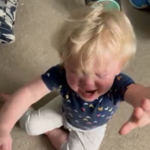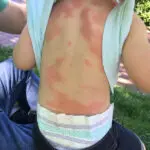Lend me your ear, dear: all things ear pain discussed
No More Worries Blog
Written by: Kelly Cotaleen Todd CPNP, AC/PC
Earaches. The. Worst. Pain. Ever. Aside from maybe tooth pain….. I’m here to dispel some myths, educate, and inform on the wretched affliction that plagues children everywhere. There are two types of ear infections: otitis externa (OE) or swimmer’s ear, which occurs when there is bacteria in the external ear canal causing inflammation, irritation, and sometimes drainage; and acute otitis media (AOM), which occurs behind the tympanic membrane (TM), caused by fluid buildup growing a bacteria, which turns into pus, and pushes on the TM.
The Basics
OE, the infection in the canal, is typically caused from moisture sitting in a dark, warm space. This can happen anytime fluid is sitting in the canal; like with swimming, bathing, or even when a child has ear tubes or a ruptured eardrum and is draining fluid constantly. Which is a perfect breeding ground for bacteria and sometimes yeast. The canal becomes inflamed and can have a thick white exudate or discharge. Sometimes the canals can become so inflamed a wick needs to be placed for the medication to get to the space it needs to be.

The infection behind the TM, (acute otitis media/AOM), is often the result of having a viral upper respiratory infection (URI), allergies, or teething; anything that causes excess mucus production. Excessive mucus production, especially for a prolonged period of a week or more, backs up in the short, straight Eustachian tubes in children’s ears. Eustachian tubes connect the middle ear to the nasal sinus cavity so fluid from the nose can easily go into the middle ear when it’s straight. As we grow, our eustachian tubes angle downward so drainage happens more efficiently with less opportunity for fluid getting trapped in the middle ear.
The Down and Dirty
Ok, now we have the basics out of the way, it’s time to talk about remedies and when to seek care. If your child is under 12 months and they are exhibiting signs of a middle ear infection (AOM) for 2-3 days, please seek care. Signs of AOM in children under a year vary by child but can include fever 100.4 or higher, ear pulling/hitting/tugging, fussiness especially when lying flat or drinking, refusing to drink/eat. You can always treat the child with pain relievers such as Tylenol/Motrin (over 6 months of age), or Arnica (over 6 months) for a couple of days if they are drinking enough fluids to have a wet diaper, at least every 8 hours. Please see your provider in this age group with no more than 3 days of symptoms, or sooner with decreased wet diapers.
Over one year of age we have a little more room to watch and wait. Ear pain from AOM can often be viral and clear on their own in a couple of days, with minimal interventions. All great news!
So now for some non-pharmaceutical interventions of AOM.
Chiropractic care
Chiropractic care has a great reputation for helping adjust the spine and ears to facilitate fluid drainage.
- Make sure the provider is well-versed in pediatric care, reach out to your provider for recommendations if they do not have any make sure the chiropractor has had training in pediatric care.
- Get recommendations/referrals. Oftentimes, word of mouth is great. Talk to friends, colleagues, providers, anyone who you trust to give a great recommendation.
Coconut oil drops
Using the liquid version of coconut oil drops can help with OE, if the swelling is minimal, due to antibacterial/antifungal properties and can help ease pain as well. Coconut oil also helps if the ear is itchy, as it lubricates the canal and relieves dryness. Additionally, coconut oil can soften hard ear wax, making it easier to remove and alleviate pain.
- make sure it’s extra virgin and unrefined.
- With the child lying on their side, use a dropper to place 1-2 drops slowly and directly into the affected ear. This can be down once or twice daily.
- Next, have the child remain on their side for 5-10 minutes to get the full benefit.
Ginger
Ginger has natural anti-inflammatory properties
- Rubbed on the outer canal only, not directly into the canal.
- You can boil ginger root in coconut oil and once it has cooled, then rub on the outer canal of the affected ear 1-2 times daily.
- Using 100% ginger juice is also an alternative to creating your own, this might be a stickier option but easy in a pinch.
Uncooked rice and salt
Combine a cup of uncooked rice and a teaspoon of salt; place mixture in a thick, clean, white (no dyes or bleach) cotton sock. Next, add the sock and a cup of water to the microwave for 1-2 minutes, which results in a nice, warm, and moist heat.
- Using your fingers, massage the mixture to ensure there are no hotspots.
- Place on the ear that hurts, for 15-20 minutes every hour as needed.
- You can also use a heating pad if you do not have uncooked rice for a similar effect.
Coarse ground sea salt
Sea salt has been shown to have the ability to draw out inflammation as well as soothe pain.
- Place 1-1.5 cups of ground sea salt in a thick, clean white cotton sock and tie a knot at the top.
- Warm in the microwave 1-2 minutes, or in a non-toxic pan on the stove.
- Mix to ensure no hotspots
- Place on the affected ear for 15 minutes, as needed.
Things to use with caution:
- Garlic oil
- I know this has a lot of press and has shown to ease pain; however, hear me out. I have seen a lot of children develop OE and even yeast infections from this remedy. Also, this remedy makes it very difficult to see the TM because it tends to become thick and white, occluding the entire canal. The liquid coconut oil alone is a better option and can help just as much and is less stinky so win-win.
- Never put anything in the ear if your child develops sudden thick drainage that comes out of their canal. This often indicates the eardrum has ruptured from the pressure of the buildup of pus from a bacterial infection. If this occurs, please call your provider. They should examine your child and order oral antibiotics as well as antibiotic drops for this type of infection.
No More Worries Takeaways
- If your child is under the age of one and has any of the symptoms of an ear infection discussed above for 1-2 days, seek care.
- Over one year of age, you can watch and wait 2-4 days while trying out pain relievers and/or natural remedies discussed above.
- If your child has a sudden onset of thick discharge coming from their ear, please call your provider.




